| dc.contributor.author | Lønøy, Bjarte | |
| dc.date.accessioned | 2021-08-17T12:59:24Z | |
| dc.date.available | 2021-08-17T12:59:24Z | |
| dc.date.issued | 2021-08-20 | |
| dc.date.submitted | 2021-07-16T09:03:53.024Z | |
| dc.identifier | container/d3/5d/10/72/d35d1072-8612-49f9-a0cb-376f3763b753 | |
| dc.identifier.isbn | 9788230846865 | |
| dc.identifier.isbn | 9788230848227 | |
| dc.identifier.uri | https://hdl.handle.net/11250/2768914 | |
| dc.description.abstract | A significant proportion of the world's hydrocarbon production comes from paleokarst reservoirs. Although these reservoirs boast some of the most productive wells in oil history, the recovery factor is relatively low (RFmean: 32%) compared to other carbonate reservoirs (RFmean: 37 - 51%). The low recovery could relate to current reservoir modelling approaches potentially yielding inaccurate resource estimates or early water-breakthrough. Conventional industry-standard reservoir modelling software suites do not have dedicated workflows or add-ins for handling the complex morphologies commonly associated with paleokarst. Current modelling approaches are often datadriven (conditioned on available seismic and well data) and employ adapted or modified versions of stochastic reservoir modelling workflows used for siliciclastic and carbonate reservoirs. However, many paleokarst features are below seismic resolution, and the representativity of individual well data is often challenging to assess. Consequently, data-driven models often fail to render the connectivity, geometry, and volume of karst features. Karst is the predecessor to paleokarst, and therefore a genetic approach employing existent information from recent karst systems may be a good starting point for generating analogues to paleokarst reservoirs. A concept-driven approach, in combination with current data-driven modelling approaches, may enable model rendering that more closely echoes actual paleokarst reservoir architectures. However, only a few conceptual modelling methods are publicly available and described in the literature. The drawbacks with the available methods are that they under-/overestimate the cave volumes, fail to provide realistic cave morphologies, and forecast clastic sediment infill, and do not differentiate between preserved and collapsed caverns. Consequently, post-collapse reservoir morphologies, volumes and facies distributions may be rendered inaccurately. This thesis aims to address the shortcomings of currently available conceptual methods and present a novel concept-driven workflow for paleokarst reservoir modelling.
A novel methodology for geocellular rendering of karst systems is presented in this thesis. The method utilizes modern cave-survey data to generate dense, equally spaced point-clouds (infilling the cave periphery). These point clouds can be used to discretize the karst systems in a geocellular framework by geometrical modelling. The volumetric and geometric rendering of the method is compared with two pre-established methods and benchmarked against the cave survey. The results show that the new method offers improved volumetric and geometric geocellular rendering compared to the preestablished methods and are comparable to that of the cave survey.
A pilot study using a well-known and pre-established geophysical method, electrical resistivity tomography (ERT), was carried out in the Maaras cave system in northern Greece to evaluate the large-scale volumetric significance and spatial distribution of clastic sediments infilling karst cavities. ERT proved to be a practical and useful method for differentiating mesoscale (>2.5 m2) stratigraphic heterogeneity. Resistivity contrasts allowed the identification of sedimentary thickness variations, interbedded breccias, and cave floor. Results showed that the siliciclastic sediment thickness varied from 25 m to >45 m, occupying a minimum of 69-95 % of the available accommodation space.
Finally, a novel interactive tool for evaluating cavern stability and forward model collapse and infill processes was developed. The tool employs conventional cave survey data, field measurements and geomechanical data of the host rock to simulate potential post-collapse morphologies and generate spatial output data suitable for geocellular modelling. Collapse propagation, and eventually the volume affected by the collapse, is controlled by user-defined paleokarst facies proportions and associated average porosities following a “mass-balance-principle” (i.e., porosity is final and only redistributed over a larger volume). Three different collapse scenarios were modelled using the Agios Georgios cave system in northern Greece as an analogue. The results show that it is feasible to use cave surveys to simulate collapse and infill processes and estimate the final paleokarst reservoir architecture. The morphology, volume and relative facies-proportions rendered in the reservoir models are comparable to those calculated in the forward collapse modelling tool, indicating that the geocellular model echoes the simulation. The results also show that the vertical continuity and target volume of a reservoir increases significantly with increasing bedding dip. This suggests that improved forecasting of the final reservoir architecture may optimise well positioning, production planning and eventually improve recovery prediction. | en_US |
| dc.language.iso | eng | en_US |
| dc.publisher | The University of Bergen | en_US |
| dc.relation.haspart | Paper 1: Lønøy, B., Tveranger, J., Pennos, C., Whitaker, F., & Lauritzen, S. E. (2020). Geocellular rendering of cave surveys in paleokarst reservoir models. Marine and Petroleum Geology, 122, 104652. The article is available at: <a href="https://hdl.handle.net/11250/2761597" target="blank">https://hdl.handle.net/11250/2761597</a> | en_US |
| dc.relation.haspart | Paper 2: Lønøy, B., Pennos, C., Tveranger, J., Fikos, I., Vargemezis, G., & Lauritzen, S. E. (2021). Delimiting morphological and volumetric elements of cave surveys as analogues for paleokarst reservoir modelling – A case study from the Maaras cave system, northern Greece. Marine and Petroleum Geology, 129, 105091. The article is available in the thesis file. The article is also available at: <a href="https://doi.org/10.1016/j.marpetgeo.2021.105091" target="blank">https://doi.org/10.1016/j.marpetgeo.2021.105091</a> | en_US |
| dc.relation.haspart | Paper 3: Lønøy, B., Pennos, C., Tveranger, J., Fikos, I., Vargemezis, G., & Lauritzen, S. E. A concept-driven approach to paleokarst reservoir modelling. The article is not available in BORA. | en_US |
| dc.rights | In copyright | |
| dc.rights.uri | http://rightsstatements.org/page/InC/1.0/ | |
| dc.title | Paleokarst reservoir modelling - A concept-driven approach | en_US |
| dc.type | Doctoral thesis | en_US |
| dc.date.updated | 2021-07-16T09:03:53.024Z | |
| dc.rights.holder | Copyright the Author. All rights reserved | en_US |
| dc.contributor.orcid | 0000-0003-1900-9999 | |
| dc.description.degree | Doktorgradsavhandling | |
| fs.unitcode | 12-50-0 | |
